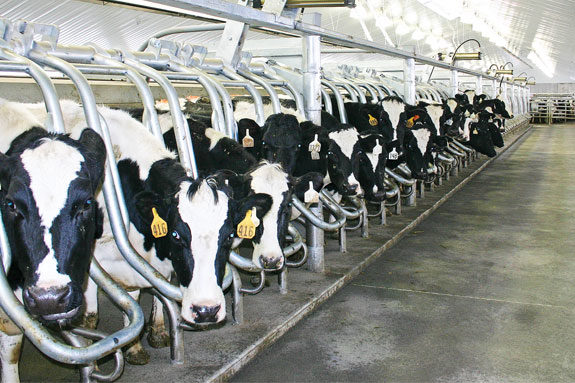When talking about employer/employee relations, the topic of interaction frequently comes up. These discussions are usually centered on people; they don’t normally consider the most valuable employees on the farm – the cows. What is communicated to them by way of your actions or those of your human employees?
Several studies around the world have attempted to make solid correlations between cow handling procedures, cow behavior, health and productivity.
The results are mixed, but some findings make sense and have prompted others to study further.
Seabrook reported “some significant associations between the personality of the stockperson and milk production” as “cows in highest-yielding herds were the most willing to return from pasture and enter the milking shed and were less restless in the presence of the stockperson.”
Rushen et. al. reported that compared to a control milking group, the presence of a gentle handler did not change milk yield or residual milk. The presence of an aversive handler (handling techniques showing a dislike of the animals) increased residual milk by 70 percent. Some cows seemed better able to differentiate between gentle and aversive handlers.
Their conclusion was that “care should be taken to not invoke fear in cows and ensure that the people responsible for the cows find the least aversive means of handling them.”
Hemsworth et. al. identified a significant correlation between negative handling techniques and the proportion of cows conceiving at first insemination. This accounted for only 14 percent of the variation, but it still seemed to be a factor worth noting.
A brief summation of those studies would suggest gentle handling may not increase productivity, but forceful, aggressive handling may very well decrease productivity and breeding response.
Can a cow be handled too much and/or too gently? The answer appears to be “maybe.” Breuer et. al. found a negative correlation between gentle handling and the approachability of cows in some of their study herds. In those same herds, however, there was a positive relationship toward conception rates.
If you ask producers who have present or former showring cows in their herds, they might also use a term like “halter dumb” for those cows who seem to be less-than-cooperative when trying to move them around. They have become too accustomed to human handling and control. Fortunately, in most herds they are a minority.
What does this all mean to you as a producer? The studies found that employees who were more aggressive toward animals were also identified during interviews and attitude tests to be less interested in livestock, or even had an aversion to animals. They may have taken the job simply because it was a job, not because they wanted to work with cows.
Attempts to gauge a prospective employee’s attitude toward cattle may give you some indicator of how they will act around and handle cattle as employees.
How employees feel about animals is also likely to affect how observant they are of abnormal conditions of animals. If one doesn’t really care much about cows, how likely are they to note an animal that is sore on its feet, isn’t eating well or whose milk production is decreased significantly at any given milking?
If cows are able to sense humans who are rough handlers of livestock, this will also affect how cows come into milking parlors and how well cows respond to normal milking preparation, even if proper protocols are followed.
What can you do to provide a calmer atmosphere for the animals that at least optimizes their cooperation in the barn and encourages milk letdown? Here are suggested strategies from the National Milk Harvesting Centre (Victoria, Australia) to reduce the fear cows have of humans:
1. Reduce excessive noise, such as banging gates and shouting.
2. Reduce negative interactions (prods, sticks, etc.) and use positive interactions (low voice, gentle taps, etc.) more frequently.
3. Examine routine habits when handling cows and remove actions that could induce fear.
4. Minimize or remove negative or painful procedures from the parlor and perform them elsewhere in the dairy.
5. Use solid panels to screen off unfamiliar procedures.
6. Keep the dairy routine consistent and allow cows time to learn new changes on the farm.
7. Move cattle as a group, rather than individually to decrease fear associated with handling.
Add to these strategies a training program for employees that emphasizes how their interactions with cows can affect productivity, which affects the farm’s bottom line. None of this can guarantee more milk in the tank or money in the bank, but if some of these procedures make cows easier to handle and create less stress among the employees and managers of a farm, isn’t that of value as well?
Pleasant working conditions go a long way toward satisfied employees – whether they have two legs or four. PD
References omitted due to space but are available upon request to editor@progressivedairy.com .
—Excerpts from Iowa State University Extension “DAIRY News & Views from the ISU Extension Dairy TEAM” newsletter. Volume 29, December 2010.
PHOTO
Pleasant working conditions go a long way toward satisfied employees – whether they have two legs or four. Photo by PD staff.

Chuck Schwartau
Regional Extension Educator
University of Minnesota Extension
cschwart@umn.edu








